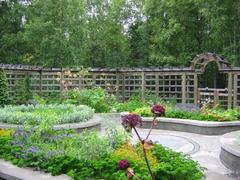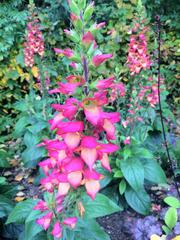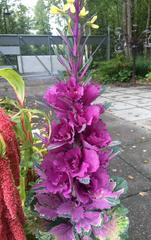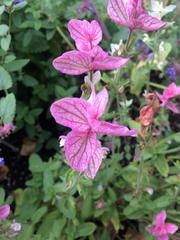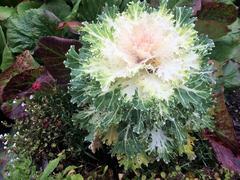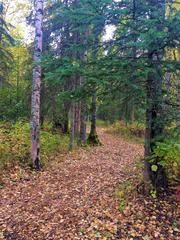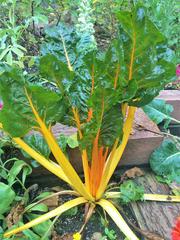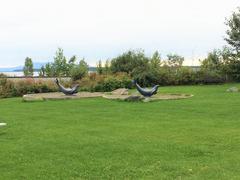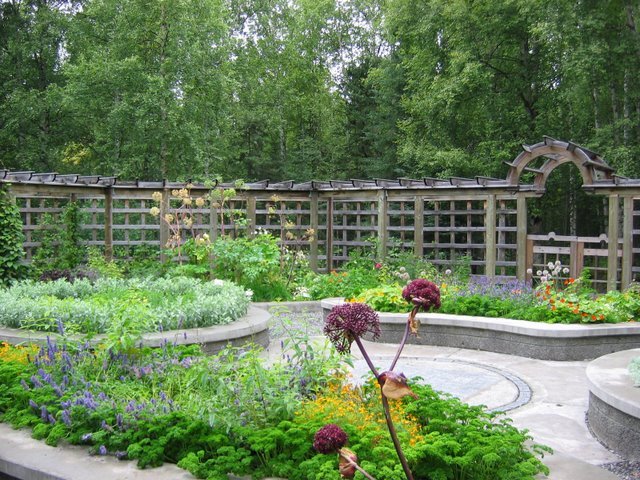
Visiting Alaska Botanical Garden: Hours, Tickets, and Tips
Date: 24/07/2024
Introduction
The Alaska Botanical Garden (ABG) in Anchorage is a remarkable destination for those interested in the unique flora of the northernmost state in the U.S. Located within the Far North Bicentennial Park, the garden spans 110 acres and showcases over 1,100 species of plants, making it a living museum of Alaska’s botanical diversity. Established in 1993 and opened to the public in 1995, the garden has since become a vital resource for education, research, and recreation.
Visitors to the ABG can explore themed areas like the Lower Perennial Garden, the Herb Garden, and the Rock Garden, each offering a unique glimpse into Alaska’s subarctic plant life. The garden is not only a visual feast but also an educational hub, offering programs for all ages, including guided tours, workshops, and lectures focused on plant conservation and the effects of climate change on local ecosystems.
The ABG’s commitment to conservation and community engagement is evident through its numerous events, volunteer programs, and collaborations with local schools and universities. Whether you’re a local resident, a tourist, or a researcher, the ABG provides a serene and informative setting to appreciate the natural beauty and ecological significance of Alaska’s native plants. For more detailed visitor information, including ticket prices and visiting hours, you can visit the official Alaska Botanical Garden website.
Table of Contents
- [History and Significance of the Alaska Botanical Garden](#history-and-significance-of-the-alaska-botanical-gardenhistory-and-significance-of-the-alaska-botanical-garden)
- [Establishment and Early Development](#establishment-and-early-developmentestablishment-and-early-development)
- [Unique Flora and Ecosystems](#unique-flora-and-ecosystemsunique-flora-and-ecosystems)
- [Visitor Information - Hours, Tickets, and Tips](#visitor-information---hours-tickets-and-tipsvisitor-information---hours-tickets-and-tips)
- [Visiting Hours and Tickets](#visiting-hours-and-ticketsvisiting-hours-and-tickets)
- [Travel Tips and Nearby Attractions](#travel-tips-and-nearby-attractionstravel-tips-and-nearby-attractions)
- [Educational and Research Contributions](#educational-and-research-contributionseducational-and-research-contributions)
- [Community Engagement and Cultural Significance](#community-engagement-and-cultural-significancecommunity-engagement-and-cultural-significance)
- [Conservation Efforts and Environmental Impact](#conservation-efforts-and-environmental-impactconservation-efforts-and-environmental-impact)
- [Visitor Experience and Accessibility](#visitor-experience-and-accessibilityvisitor-experience-and-accessibility)
- [FAQ](#faqfaq)
- [Future Plans and Developments](#future-plans-and-developmentsfuture-plans-and-developments)
- [Conclusion](#conclusionconclusion)
History and Significance of the Alaska Botanical Garden
Establishment and Early Development
The ABG was founded with the mission to showcase and preserve the unique flora of Alaska, providing a space for education, research, and recreation. The initial development was spearheaded by a group of dedicated volunteers and horticulturists who recognized the need for a botanical garden in the region. The garden officially opened to the public in 1995, covering an area of approximately 110 acres within the Far North Bicentennial Park.
Unique Flora and Ecosystems
The ABG is significant for its focus on the native plants of Alaska, which are adapted to the state’s unique climatic conditions. The garden features over 1,100 species of plants, including many that are endemic to the region. This includes a variety of wildflowers, shrubs, and trees that thrive in the subarctic environment. The garden’s collections are organized into several themed areas, such as the Lower Perennial Garden, the Herb Garden, and the Rock Garden, each showcasing different aspects of Alaska’s botanical diversity.
Visitor Information - Hours, Tickets, and Tips
Visiting Hours and Tickets
The Alaska Botanical Garden is open year-round, with seasonal variations in visiting hours. Generally, the garden is open from 9 AM to 8 PM during the summer months and from 10 AM to 4 PM in the winter. It’s always a good idea to check the official website for the most current visiting hours before planning your trip.
Ticket prices are as follows:
- Adults: $12
- Seniors (65+): $10
- Children (6-18): $7
- Children under 6: Free
- Members: Free
Tickets can be purchased at the entrance or online through the garden’s website. Group discounts and annual memberships are also available.
Travel Tips and Nearby Attractions
The ABG is located within the Far North Bicentennial Park, which offers additional recreational opportunities, such as hiking and wildlife viewing. Nearby attractions include the Anchorage Museum and the Alaska Native Heritage Center, both of which provide further insights into the region’s cultural and natural history.
Educational and Research Contributions
One of the primary roles of the ABG is to serve as an educational resource. The garden offers a range of programs for visitors of all ages, including guided tours, workshops, and lectures. These programs are designed to educate the public about the importance of plant conservation and the unique characteristics of Alaska’s flora. Additionally, the garden collaborates with local schools and universities to provide hands-on learning opportunities for students.
The ABG also plays a crucial role in botanical research. The garden’s staff and volunteers conduct ongoing research on plant propagation, conservation, and the effects of climate change on Alaska’s ecosystems. This research is vital for developing strategies to protect and preserve the state’s native plants. The garden’s herbarium, which houses a collection of preserved plant specimens, serves as a valuable resource for researchers and scientists.
Community Engagement and Cultural Significance
The ABG is deeply rooted in the Anchorage community. It hosts a variety of events throughout the year, including plant sales, garden tours, and seasonal festivals. These events not only provide entertainment and education for visitors but also help to foster a sense of community and connection to the natural world. The garden’s volunteer program is another important aspect of its community engagement, offering opportunities for individuals to contribute to the garden’s maintenance and development.
Culturally, the ABG holds significance as a space that celebrates the natural heritage of Alaska. The garden’s design and plant collections reflect the region’s unique ecological and cultural history. For example, the Alaska Native Plant Garden showcases plants that have been used by indigenous peoples for food, medicine, and other purposes. This area of the garden highlights the deep connection between the native flora and the cultural practices of Alaska’s indigenous communities.
Conservation Efforts and Environmental Impact
Conservation is a key focus of the ABG’s mission. The garden is involved in several conservation projects aimed at protecting Alaska’s native plants and their habitats. This includes efforts to restore degraded ecosystems, propagate rare and endangered species, and promote sustainable gardening practices. The garden’s staff work closely with local and national conservation organizations to advance these goals.
The ABG also emphasizes the importance of environmental stewardship. The garden’s design incorporates sustainable practices, such as water conservation, composting, and the use of native plants that require minimal maintenance. These practices not only reduce the garden’s environmental impact but also serve as a model for visitors and the broader community.
Visitor Experience and Accessibility
The ABG is designed to be accessible and enjoyable for visitors of all ages and abilities. The garden features a network of well-maintained trails that provide easy access to its various themed areas. Interpretive signage throughout the garden offers information about the plants and ecosystems on display, enhancing the visitor experience. The garden also provides amenities such as restrooms, picnic areas, and a gift shop.
For those interested in a more in-depth experience, the ABG offers guided tours led by knowledgeable staff and volunteers. These tours provide insights into the garden’s history, plant collections, and conservation efforts. The garden also hosts a variety of special events and programs throughout the year, including plant sales, workshops, and seasonal festivals.
FAQ
What are the visiting hours for the Alaska Botanical Garden?
The garden is generally open from 9 AM to 8 PM during summer and from 10 AM to 4 PM in winter. Check the official website for current hours.
How much are tickets for the Alaska Botanical Garden?
Ticket prices are $12 for adults, $10 for seniors, $7 for children aged 6-18, and free for children under 6. Members enjoy free admission.
Future Plans and Developments
Looking ahead, the ABG has ambitious plans for expansion and development. The garden aims to increase its plant collections, enhance its educational programs, and expand its research and conservation efforts. Future projects include the development of new themed gardens, the construction of additional facilities, and the implementation of new sustainability initiatives.
The ABG’s commitment to growth and innovation ensures that it will continue to be a valuable resource for the Anchorage community and a destination for visitors from around the world. As the garden evolves, it will remain a testament to the beauty and diversity of Alaska’s native flora and a beacon for plant conservation and education.
Conclusion
The Alaska Botanical Garden is more than just a garden; it’s a living museum dedicated to the flora of Alaska. With its rich history, diverse plant collections, and extensive educational and conservation programs, the ABG offers something for everyone. Whether you’re a local resident or a visitor, a trip to this Anchorage historical site promises a unique and enriching experience.
For more information about the Alaska Botanical Garden, visit the official website and follow them on social media for updates and upcoming events.
References
- Alaska Botanical Garden. (n.d.). Explore the Alaska Botanical Garden - Visiting Hours, Tickets, and Historical Significance. Retrieved from https://www.alaskabg.org
- Alaska Botanical Garden. (n.d.). Complete Guide to Visiting the Alaska Botanical Garden - Hours, Tickets, and Highlights. Retrieved from https://www.alaskabg.org
- Alaska Botanical Garden. (n.d.). Visiting Alaska Botanical Garden - Hours, Tickets, and Tips for an Unforgettable Visit. Retrieved from https://www.alaskabg.org
